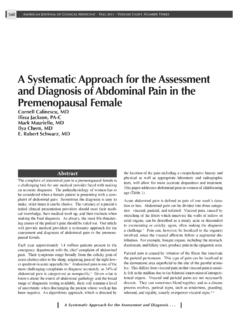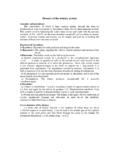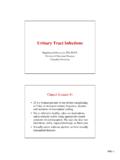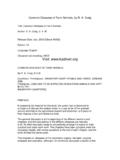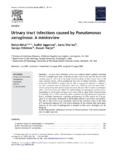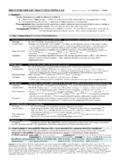Transcription of Urinary Tract Infection Update - American Association of ...
1 American Journal of Clinical Medicine Summer 2012 Volume Nine Number Two82 AbstractUrinary Tract infections are commonly treated in urgent care practice. Clinicians need to be aware of the advantages and limitations of diagnostic tests, as well as the proper empiric an-tibiotic treatment of these infections , in order to effect the best outcomes for patients. Several recent articles and a published guideline provide the most up-to-date information and form the basis of this Tract Infection (UTI) is a common problem diagnosed and treated in urgent care medicine practice. A 2010 report in-dicated that of urgent care visits were for An esti-mated eight million episodes of UTI occur in the US each year2 with one out of three women requiring treatment for UTI before age Urinalysis and urine gram stain and culture may assist with diagnosis, but add to the cost of care and are not always necessary.
2 UTIs can affect the lower Urinary Tract (cystitis) or upper Tract (pyelonephritis). Similar to other acute infections , initial antibiotic treatment for cystitis is empiric. A variety of antibiotics is available for treating UTIs, but changing antibi-otic sensitivities make appropriate empiric treatment a moving target over time. A recently published guideline4 by the Infec-tious Diseases Society of America and European Society for Microbiology and Infectious Diseases provides evidence-based recommendations for treating pre-menopausal, non-pregnant females with uncomplicated UTI. UTIs which occur in men, pregnant women, and patients with immunosuppression or uri-nary Tract abnormalities, such as congenital malformations, uri-nary calculi, recent urologic instrumentation, indwelling cath-eters, neurogenic bladder, and kidney transplant, are considered complicated and require more complex decision-making than will be reviewed in this Update .
3 Because the majority of UTIs are uncomplicated, however, this review should have broad DiagnosisDiagnosis of UTI in young healthy patients can usually be made clinically. Patients with cystitis typically present with any or all of the following: cloudy urine; abnormal urine odor; dysuria; Urinary frequency, hesitancy, or urgency; suprapubic discomfort; gross ,6 More severe symptoms are more predictive of UTI than milder ones,5 as is the presence of combinations of symptoms rather than just a single Complaints of vaginal discharge or vaginal irritation and the absence of dysuria or back pain reduce the likelihood of Pyelonephritis typically causes fever, chills, malaise, flank dis-comfort, nausea/vomiting, and/or abdominal pain, with or with-out concomitant lower Urinary Tract cystitis, there may be no physical exam abnormalities or only mild suprapubic tenderness to palpation, while pyelo-nephritis typically causes a patient to look systemically ill in general.
4 With costovertebral angle tenderness to percussion on physical exam in most cases. These patients may also have mild tenderness of the anterior upper quadrants of the abdomen overlying the kidneys. Though UTI is more common in women than men, symptoms and physical exam findings are usually similar in both Tract Infection UpdateKim Gibson, MDJoseph Toscano, MD American Journal of Clinical Medicine Summer 2012 Volume Nine Number Two83 Older patients can present more of a diagnostic challenge and may have nonspecific symptoms such as malaise, fatigue, an-orexia, or even fever or chills, without any of the more focal symptoms above to guide the clinician to the Urinary Tract as the source of the problem.
5 UTI should be part of a fairly broad differential diagnosis for such , those with symptoms of UTI may uncommonly have other disorders. Patients with sexually transmitted infec-tions, as well as urethritis, cervicitis, and vulvovaginitis from other causes, can present with symptoms similar to cystitis. Some patients with ureterolithiasis may have only mild flank pain or lower Urinary Tract symptoms. Pelvic inflammatory disease , appendicitis, and sigmoid diverticulitis are among the entities which have been misdiagnosed as acute cystitis. Inter-stitial cystitis is uncommon but often initially indistinguishable from acute infectious a reasonable differential diagnosis for each patient and performing a careful history and physical examination with focused testing is the time-honored approach.
6 Diagnoses such as those above in addition to Infection with a resistant organ-ism or UTI combined with some element of Urinary Tract ob-struction should be considered in patients who do not improve promptly with usual empiric therapy. Of course, nonspecific symptoms like malaise, fatigue, anorexia, fever or chills can have many causes. Even with an abnormal urinalysis in hand, the careful clinician should avoid premature diagnostic closure, because Urinary Tract colonization is not uncommon in older patients and may be unrelated to a patient s presenting TestingUrinalysis (UA) is a relatively simple, office-based test that can be used to evaluate patients with Urinary complaints.
7 In ur-gent care settings where UA is available, dipstick results rather than microscopic analysis may be more likely to be utilized. The different components of dipstick testing vary in their ac-curacy for predicting Infection , with nitrite having the highest specificity (adjusted odds ratio of in one study5) but poor sensitivity ( , it will be negative in many patients who have a UTI). The combination of dipstick-positive leukocyte esterase and blood may have the highest sensitivity (77%) and specific-ity (70%).5 Urinalysis results may also suggest diagnoses other than UTI or the need for additional history or examination, as when clue cells or trichomonads are found in a culture is traditionally the gold standard for diagnosing UTI, and, though a culture showing no growth essentially rules out UTI caused by the most common organisms, sensitivity and specificity will vary depending on the threshold colony count used and whether a specimen is obtained by catheterization or other methods.
8 As well, the time required for culture results often exceeds the time to clinical cure with empiric treatment, and cultures can add significantly to the cost while not improv-ing the quality of care in the majority of with any clinical situation, diagnostic tests should be used when their results may improve management compared with not using them. The finding that, in patients with at least one UTI symptom, even a completely normal further history, physi-cal exam, and dipstick UA cannot rule out UTI6 is often used as a rationale to not perform UA in patients with typical symp-toms. Still, UA may have some use when there is diagnos-tic uncertainty, and, though it requires microscopy, findings of pyuria without bacteriuria increase the chance that a sexually transmitted Infection rather than a UTI is present.
9 An interest-ing study7 showed no significant difference in clinical outcomes whether patients were treated with antibiotics, in an immediate or delayed fashion, based on symptoms alone or based on UA results, though antibiotics were used less often if testing or de-layed prescribing was employed. A cost effectiveness analysis8 showed that basing antibiotic treatment on dipstick testing was cost-effective, compared with treating immediately without testing, if avoiding a day of moderately severe symptoms was valued at $15 (10 British pounds) or more. Though the mon-etary cost may not be directly paid by them, this is probably the case for most patients!Urine culture ideally obtained before and without delaying an-tibiotics is recommended in patients with acute pyelonephritis4 and in the management of pediatric UTIs.
10 Culture is also rec-ommended in patients with complicated UTIs (men, pregnant women, and patients with immunosuppression or Urinary Tract malformations, Urinary Tract stones, recent urologic instrumen-tation, indwelling catheters, neurogenic bladder, and kidney transplant) and may also be helpful, while starting empiric therapy, in patients with a previous history of known resistant infections , failure of empiric antibiotics, or multiple recurrent UTIs. The yield of culture is lower in patients who are taking antibiotics at the time of blood work (CBC, chemistry panel, blood culture) rarely helps decision-making for patients with uncomplicated UTI, and no useful role has been shown for erythrocyte sedimen-tation rate (ESR) or C-reactive protein (CRP).
